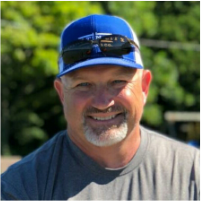
Pest Management Topics
Printable conference program
-
11. Updates on EPA’s Endangered Species Act and pesticide efforts (1.0 PM)
Doug Jones, regional agriculture advisor, US Environmental Protection Agency, Lenexa, KS
The U.S. Environmental Protection Agency (EPA) recently released guidance to pesticide registrants to improve the efficiency of EPA’s Endangered Species Act (ESA) analyses for new pesticide active ingredient applications and active ingredients undergoing registration review. What changes are ahead and what impacts might there be on Iowa agriculture?
Session E - Monday, 1:00 PM - 1:50 PM
-
12. Panel discussion on the impacts of the Endangered Species Act for Midwestern agriculture (1.0 PM)
Doug Jones, regional agriculture advisor, US Environmental Protection Agency, Lenexa, KS, Kraig McPeek, field office supervisor, US Fish and Wildlife Service; Reuben Baris, regulatory policy leader, Corteva Agriscience; Kellie Blair, Blair Farm LLC, Dayton, IA.
As a follow-up to workshop 11, four panelists representing agency, industry and production agriculture will provide their thoughts on the impacts of the Endangered Species Act. Bring your questions and join the discussion.
Session F - Monday, 2:00 PM - 2:50 PM
-
13. IPM 101: The pinnacle of pest management quizzes (1.0 PM)
Meaghan Anderson, extension field agronomist, Iowa State University Extension and Outreach, Ames, IA; Ashley Dean, education extension specialist, Iowa State University; Chelsea Harbach, plant disease diagnostician, Iowa State University
Join this fun, interactive and fast-paced weed, insect, and disease quiz - if you dare! We'll laugh, some will cry, and we'll give a few prizes to those that prove themselves to be the most superior of IPM experts!
Session M - Tuesday, 1:00 PM - 1:50 PM
Session N - Tuesday, 2:00 PM - 2:50 PM
-
14. Group 15 + Group 4 = Group 5??? (1.0 PM)
Aaron Hager, professor and extension weed specialist, Crop Sciences, University of Illinois Urbana-Champaign, Urbana, IL
The continual evolution of weed species and populations resistant to herbicides from one or more site-of-action groups represents one of the most daunting challenges facing Illinois soybean producers. Waterhemp has evolved resistance to herbicides from more site-of-action groups than any other Illinois weed species, including resistance to Group 2, 4, 5, 9, 14, 15, and 27 herbicides. With herbicide efficacy in jeopardy, this session will focus on optimizing integrated weed management programs for the greatest long-term, sustainable solution for weed populations demonstrating resistance to herbicides from multiple groups.
Session A - Monday, 9:00 AM - 9:50 AM
Session B - Monday, 10:00 AM - 10:50 AM
-
15. From field to sky: How drones are transforming aerial agricultural applications (1.0 PM)
Dennis Bowman, Extension digital agriculture specialist, University of Illinois Urbana-Champaign, Urbana, IL
Drones have moved from a novelty to a standard tool for crop scouting and field mapping. Now unmanned aerial vehicles (UAVs) are starting to replace manned aircraft for aerial applications of pesticides, fertilizers and seeds. Is this a fad or a realistic alternative? Do you have a hidden desire to be a crop duster?
Session K - Tuesday, 10:10 AM - 11:00 AM
Session L - Tuesday, 11:10 AM - 12:00 PM
-
16. Dectes texanus – not just another boring insect (1.0 PM)
Brian McCornack, professor and head, Entomology, Kansas State University, Manhattan, KS
In this presentation, we delve into the multifaceted aspects of dealing with Dectes texanus, commonly known as the "Soybean Stem Borer." This pest, native to North America, poses a significant threat to soybean crops in affected regions and continues to expand into new production areas. The presentation will provide a comprehensive exploration of Dectes stem borer, including information on its background, identification, and current management strategies. By understanding its lifecycle, host plants, and economic impact, we aim to equip crop professionals with valuable insights on how to scout and manage this economically important agricultural pest.
Session G - Monday, 3:10 PM - 4:00 PM
Session H - Monday, 4:10 PM - 5:00 PM
-
17. Don't get burned by blister beetles in alfalfa hay (1.0 PM)
Erin Hodgson, professor and extension entomologist, Plant Pathology, Entomology and Microbiology, Iowa State University, Ames, IA
There were many observations of blister beetles in alfalfa this summer. Ingestion of infested hay can result in a range of symptoms, including death. This presentation will review identification and scouting for beetles, and management recommendations to protect animals.
Session I - Tuesday, 8:00 AM - 8:50 AM
Session J - Tuesday, 9:00 AM - 9:50 AM
-
18. Exploring the science behind white mold of soybean (1.0 PM)
Daren Mueller, professor and extension crop plant pathologist, Plant Pathology, Entomology and Microbiology, Iowa State University, Ames, IA
White mold continues to be one of the more destructive soybean diseases in Iowa. This presentation will unpack the scientific literature to explain why this disease is hard to predict and manage.
Session G - Monday, 3:10 PM - 4:00 PM
Session H - Monday, 4:10 PM - 5:00 PM
-
19. When it comes to corn disease, the triangle rules! (1.0 PM)
Alison Robertson, professor and extension crop plant pathologist, Plant Pathology, Entomology and Microbiology, Iowa State University, Ames, IA
Disease will ONLY occur when a susceptible host, virulent pathogen and environmental conditions are conducive for infection. The National Predictive Modeling Tool Initiative has monitored pathogen populations and disease development at approximately 18 locations in nine U.S. states. since 2020. These data are being used to construct models for important corn diseases and will be used to develop prediction tools for farmers that enable judicious use of disease management practices. A summary of statewide corn fungicide trials will also be presented.
Session M - Tuesday, 1:00 PM - 1:50 PM
Session O - Tuesday, 3:00 PM - 3:50 PM
-
20. SCN management: Are we turning the corner? (1.0 PM)
Gregory Tylka, professor, Plant Pathology, Entomology and Microbiology, Iowa State University, Ames, IA
The soybean cyst nematode (SCN) continues to cause substantial yield loss in Iowa and throughout the Midwest. The nematode thrives in hot, dry soils, so SCN reproduction and its associated yield losses are expected to be great in 2023. The current situation with SCN will be explained in this session and new management recommendations presented.
Session K - Tuesday, 10:10 AM - 11:00 AM
Session L - Tuesday, 11:10 AM - 12:00 PM
-
21. Crown rot of corn: Who's to blame? (0.5 PM)
Alison Robertson, professor and extension crop plant pathologist, Plant Pathology, Entomology and Microbiology, Iowa State University, Ames, IA; Daniel Kimtai, graduate research assistant, Plant Pathology, Entomology and Microbiology, Iowa State University
Crown rot can affect corn at any growth stage resulting in premature death of plants. There is limited research on this disease, and Fusarium species have always been accused of being the culprits. But is Fusarium to blame? In this presentation, we will share suspects we have recovered from two years of experimental plot trials evaluating in-furrow and foliar fungicide applications to mitigate crown rot.
Session C - Monday, 11:00 AM - 11:25 AM
Session D - Monday, 11:35 AM - 12:00 PM









